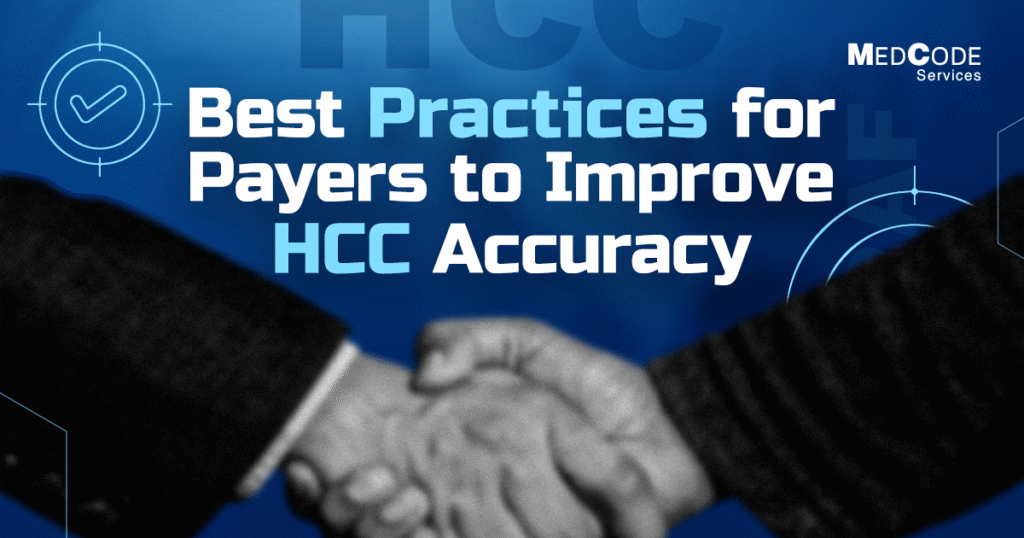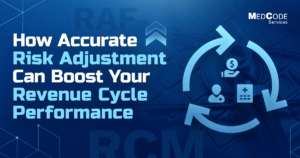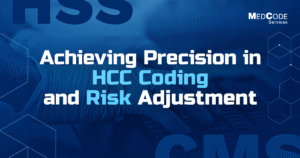The U.S. Department of Health and Human Services notes that about 1 in 10 payments to Medicare Advantage groups are inaccurate, usually because some diagnoses aren’t backed up.
Such inaccuracies have a direct impact on risk adjustment factor (RAF) scores, reimbursement rates, and compliance.
Providers juggle with heavy patient loads and endless paperwork. Payers, on the other hand, scramble to get timely, accurate data. This misalignment can cause several concerns, such as undercoding, lost revenue, and compliance risks.
To address and tackle these challenges, payers can adopt targeted strategies that strengthen collaboration with providers, close documentation gaps, and leverage analytics for smarter RAF tracking.
At MedCode, we aim at working closely with payers to take these issues head-on, combining analytics, training, and hands-on support to strengthen HCC accuracy.
Partnering with Providers for HCC Accuracy
Effective collaboration between payers and providers is the core element on which strong HCC coding relies. Both trust and alignment are critical; payers that invest in real partnerships often see better documentation and fewer gaps.
Ways payers can build productive partnerships include
- Address past challenges: Acknowledge past misalignments and demonstrate commitment to supporting providers. Clear, honest communication really matters. When teams get to see transparency and openness concerning past mistakes or misalignments, they get encouraged to work together.
- Work with purpose: Approach HCC coding as a shared goal, not just a compliance task. Show how complete documentation benefits everyone.
- Practical training: Using real chart reviews and current coding trends as a base for practical training purposes makes it more relatable. Also, hands-on examples make learning relevant and actionable.
- Align financial incentives: Reward accurate and complete coding instead of focusing on patient volume alone, thus boosting the significance of thoughtful coding.
- Support preventive care: Complete documentation can often shed light on opportunities for screenings, chronic disease management, and preventive interventions that might otherwise get missed.
- Foster mutual accountability: Mutually shared responsibility ensures both payers and providers are invested in capturing the full clinical picture, leading to prompt spotting of errors and improvement of RAF scores.
Addressing Gaps for Stronger HCC Capture
Capturing every relevant HCC code is a complicated task, especially when patient data is disorganized and scattered across EHRs, claims, and other sources.
Proactive measures to close gaps and improve coding quality
- Pre-visit chart reviews: Reviewing patient charts before appointments often highlights missing or unclear diagnoses. Providers then have a clearer idea or more accurate documentation.
- Integrate audits into workflows: Embedding small, regular audits into routine processes helps catch discrepancies early. Gradually, these practices help teams form steadier coding routines.
- Pre-claim quality checks: Spotting errors before claims submission minimizes post-claim corrections and compliance issues. Even small tweaks here save a lot of time.
- Knowledge support: Short reminders or mini-training sessions can help clinicians stay updated on coding changes while keeping workloads manageable.
- Reduce administrative burden: Share documentation tasks across teams. This lets clinicians spend more time with patients and still keeps coding decent.
- Continuous improvement cycle: Combining reviews, audits, and checks creates a feedback loop. Coding gaps gradually close, and RAF scores stabilize naturally.
MedCode seamlessly integrates gap-closure audits and pre-visit reviews directly into its payer workflows, ensuring the process remains complication-free.
Leveraging Data and RAF to Strengthen HCC Accuracy
Analytics and RAF tracking aren’t just numbers; they’re tools that reveal patterns, which further help payers pinpoint coding gaps and guide decision-making in real time.
- Compare current and prior data: Looking at coding year-over-year ensures continuity in the capture of chronic conditions. Discrepancies can be swiftly identified and addressed.
- Use predictive analytics: Highlighting undocumented conditions gives coding teams a proactive edge. Sometimes a condition may not appear obvious in the current chart but emerges from patterns in previously collected data.
- Track high-impact categories: Prioritize diagnoses that have the largest effect on RAF scores and reimbursement to make coding efforts more efficient.
- Quarterly RAF reviews: Regular assessments of RAF metrics reveal trends and gaps, allowing adjustments before annual audits.
- Communicate benchmarks clearly: Sharing performance metrics with teams aligns expectations and fosters accountability without the need of scrutinizing and micromanaging.
- Standardize RAF tracking: Integrating monitoring into operational reporting keeps insights actionable and consistent.
At MedCode we implement these strategies on a practical level, thus helping payers quickly bridge gaps and maintain coding accuracy across the board.
Sustaining Compliance and Audit Readiness
Compliance isn’t a one-time task; it’s ongoing. Continuous monitoring and preparation reduce risks and support improvement in RAF scores.
- Keep documentation in line with standards: Regularly reviewing provider notes and coding helps stay on track with CMS and payer rules.
- Conduct mock audits: Simulated audit scenarios uncover gaps and offer feedback before external reviews, which helps avoid surprises.
- Continuous monitoring: Dashboards and reports track trends and flag anomalies in real time, keeping teams proactive.
- Educate and support staff: Regular training ensures coders and clinicians stay updated with the latest trends, best practices, and expectations.
- Leverage technology and analytics: Tools highlight high-risk areas, detect abnormalities, and guide corrective actions efficiently.
- Embed compliance in workflows: Incorporating SOPs and small checks into daily operations reduces last-minute reliance on ad hoc measures.
These practices run live at MedCode, helping payers maintain accurate coding, close gaps quickly, and stay audit-ready without fail.
Conclusion
Precise HCC coding can never be a one-time task. Getting this process right isn’t optional. It affects how patients are cared for, how reimbursements flow, and whether compliance holds up, year after year. Success comes from a steady collaboration between payers and providers, reinforced by data-driven checks and practical education for teams on the ground.
Accuracy improves when it’s part of daily routines. Chart reviews, RAF tracking, and audits become second nature instead of being last-minute tasks. This not only reduces compliance risks but also supports stronger patient outcomes.
At MedCode, these steps aren’t just ideas; they’re part of the daily routine. They help payers keep pace with CMS updates and adjust smoothly as regulations change. By balancing analytics with hands-on guidance, we make coding accuracy sustainable, reliable, and future-ready.
Frequently Asked Questions
- How can payers spot missing HCC codes?
Looking at past charts and running quick pre-claim checks can often help in revealing diagnoses that might otherwise be missed.
- Can audits improve HCC capture?
Yes, but it’s the small, routine checks that really help. They catch gaps quite early on, build consistency, and reduce the need for corrections later. At MedCode, we run these audits continuously to help payers stay ahead of compliance issues.
- Will small interventions really improve coding?
Yes. Quick reminders, practical examples, and easy-to-follow tips make documentation stronger without adding extra work. MedCode applies these strategies in real time, giving coding teams daily, actionable insights.







